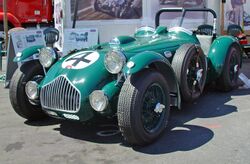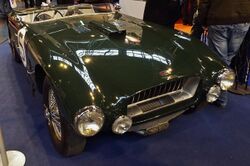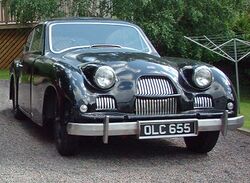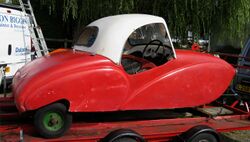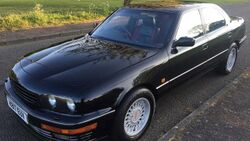Allard Motor Company
Topic: Company
 From HandWiki - Reading time: 10 min
From HandWiki - Reading time: 10 min
 | |
| Industry | Automotive |
|---|---|
| Fate | Insolvency |
| Founded | 1946 |
| Founder | Sydney Allard |
| Defunct | 1958 |
| Headquarters | Clapham , England |
| Owners |
|
| Website | www |
Allard Motor Company Limited was a London-based low-volume car manufacturer founded in 1945 by Sydney Allard[1] in small premises in Clapham, south-west London. Car manufacture almost ceased within a decade. It produced approximately 1900 cars before it became insolvent and ceased trading in 1958.[citation needed] Before the war, Allard supplied some replicas of a Bugatti-tailed special of his own design from Adlards Motors in Putney.[1]
Allards featured large American V8 engines in a light British chassis and body, giving a high power-to-weight ratio and foreshadowing the Sunbeam Tiger and AC Cobra of the early 1960s. Cobra designer Carroll Shelby and Chevrolet Corvette chief engineer Zora Arkus-Duntov both drove Allards in the early 1950s.
Pre-war Allard Specials
The first Allard cars were built to compete in "trials" events – timed rally-like events on terrain almost impassable by wheeled vehicles. Built in under three weeks,[2] the first Allard was powered by a Ford flathead V8 in a body mainly pirated from a Bugatti.[2] The V8 was moved backward in the chassis to improve traction.[2] The car used the American engine's high torque to great effect in slow-speed competition.[3] It debuted at the Gloucester Cup Trials, and later won the 100 miles (160 km) event at Southport Sands.
After a time the front beam axle was converted to independent front suspension. Leslie Ballamy's rather crude method was to cut the beam in half and mount the halves as swing axles and these swing axles were used on nearly all later Allard specials.[2]
Further Allards were soon built to order. Allard's brother, Leslie, was a customer, while racer Ken Hutchinson purchased a 4.4-litre (270 cu in) Lincoln-Zephyr V12-powered version.[2] It led to the pair forming a team, dubbed Tail Waggers, to race the car, which proved quite successful, including setting a new record at the Prescott hillclimb.[2]
In 1937, Allard began producing modified Fords[2] (in much the same way as the Chevrolet brothers had in the U.S.), selling them for £450 each.[4] By the outbreak of war in 1939, twelve Allard Specials had been built. Sydney Allard's planned volume production was pre-empted by work on Ford-based trucks during the conflict. By the war's end, Allard had built up a substantial inventory of Ford parts.
Post-war models
The Allard Motor Company was founded in 1945, setting up in Clapham High Street, London.[4] Using its inventory of easy-to-service Ford mechanicals built up during World War II and bodywork of Allard's own design, three post-war models were introduced with a newly designed steel chassis and lightweight body shells: the J, a competition sports car; the K, a slightly larger car intended for road use, and the four seater L. All three were based on the Ford Pilot chassis and powered by a fairly stock 85 hp (63 kW; 86 PS) 3,622 cc (221.0 cu in) sidevalve V8 with a single carburettor and 6:1 compression, driving a three-speed transmission and low-geared rearend, for superior acceleration.[4] Front suspension was Ballamy swing axle, rear Ford solid axle.[4] They were bodied in aluminium by Allard's friend Godfrey Imhof.[4] Sales were fairly brisk for a low-volume car, and demand was high for cars in general, which led to the introduction of several larger models, the drophead coupe M and P.
Allard used "J" for the short-wheelbase two-seaters, "K" for two- or three-seat tourers or roadsters, "L" for four-seat tourers, "M" for drophead (convertible) coupes, and "P" for fixed-head cars. As models were replaced, subsequent models were numbered sequentially.[4]
J
J1
Built from 1946 to 1947, the J1 was released as a two-seater competition car together with the K1 touring two-seater and the L- Type touring 4-seater. The J1 was a starkly trimmed and equipped 2-seater competition car on a 100 in (2,500 mm) wheelbase.[4] Powered by a 140 hp (100 kW; 140 PS) 3,917 cc (239.0 cu in) overhead valve Mercury V8, the J1 had a top speed of 85 mph (137 km/h), limited by the low rear axle gearing.[4] Only 12 were produced and went only to buyers who would rally them. They had good ground clearance and the front wings were removable.[citation needed] Copies driven by Allard himself, Maurice Wick, and others, and was a successful racer.[4] Imhof won the 1947 Lisbon Rally in a J1 powered by a Marshall-supercharged version, while Leonard Potter took the Coupe des Alpes that year.[4]
J2
Sydney Allard soon saw the potential of the economically more vibrant – but sports car starved – U.S. market and developed a special competition model to tap it, the J2. The new roadster, weighing just 2,072 pounds (940 kg),[5] was a potent combination of a lightweight, hand-formed aluminium body fitted with new coil spring[4] front suspension, fitted with inclined telescopic dampers,[6][7] and de Dion-type rear axle,[3] inboard rear brakes, and 110 hp (82 kW), 267 cu in (4,375 cc) Mercury flathead V8, with the option of an Ardun hemi conversion.[4] The J2 had a disturbing tendency to catch fire when started.[5]
Importing American engines just to ship them back across the Atlantic proved problematic, so U.S.-bound Allards were soon shipped engineless and fitted out in the States variously with newer overhead valve engines by Cadillac, Chrysler, Buick, and Oldsmobile. In that form, the J2 proved a highly competitive international race car for 1950, most frequently powered by 331 cu in (5.4 L) Cadillac engines. Domestic versions for England came equipped with Ford or Mercury flatheads. Zora Duntov worked for Allard from 1950 to 1952 and raced for the factory Allard team at Le Mans in 1952 and 1953.[8]
Available both in street trim and stripped down for racing, the J2 proved successful in competition on both sides of the Atlantic, including a third place overall at Le Mans in 1950 (co-driven by Tom Cole and Allard himself[5]) at an average 87.74 mph (141.20 km/h), powered by a Cadillac V8.
J2s returned to Le Mans in 1951, one co-driven again by Cole and Allard, the other by Reece and Hitchings; Reece jumped an embankment, while the Allard car broke.[9] They had no more success in 1952, both cars failing to finish.[9]
Of 313 documented starts in major races in the 9 years between 1949 and 1957, J2s compiled 40 first-place finishes; 32 seconds; 30 thirds; 25 fourths; and 10 fifth-place finishes.[10] Both Zora Duntov and Carroll Shelby raced J2s in the early 1950s. Ninety J2s were produced between 1950 and 1952.[11]
J2X
In an effort to extend a line growing obsolete in the face of advances in sports car design, Allard introduced an 'improved' model in late 1951, the J2X (extended). The chassis remained unchanged from the previous J2,[12] but in an attempt to improve handling, the front suspension's rear attaching radius rods were redesigned with forward ones, which required a forward cross member and extending the nose past the front wheels. This, in turn, allowed the engine to be moved forward 7 1⁄2 in (190 mm),[9] yielding more cockpit room. The nose was lengthened some 6 1⁄2 in (170 mm) to accommodate the change.[9]
In standard form, the spare wheel was carried hidden on top of the rear-mounted fuel tank, but either version could carry one or two side-mounted spares. This allowed the use of a 40 gallon long distance fuel tank.[citation needed]
Arriving later, during a time when sports racing car design was developing rapidly, the J2X was not as successful in international racing as the J2, as it was not as competitive compared to more advanced C- and D-type Jaguars, alongside Mercedes, Ferrari, and Maserati works entries. Thus, it headlined less often in major international races and of 199 documented major race starts in the 9 years between 1952 and 1960, J2X's garnered 12 first-place finishes; 11 seconds; 17 thirds; 14 fourths; and 10 fifths.
One J2X chassis was given custom magnesium-alloy bodywork by Essex Aero.
JR
This 1953 car was a lightweight specialist racer, powered by a Cadillac engine claimed to produce 300 hp (220 kW; 300 PS). Entered at Le Mans that year, the Allard/Fotheringham-Parker car suffered a broken rear suspension, while the Duntov/Merrick car also retired.[9] This was the marque's last effort at Le Mans.[9] Seven cars were built in total, with the last car finished in 1956.
K
K1
| Allard K1 | |
|---|---|
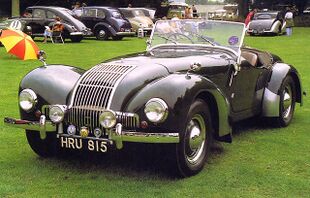 1949 Allard K1 | |
| Overview | |
| Production | 1946–1949 |
| Powertrain | |
| Engine | Ford Britain L-head V8 Canadian Mercury L-head V8 |
| Transmission | 3-speed manual |
| Dimensions | |
| Wheelbase | 2,690 mm (106.0 in) |
| |uk|Kerb|Curb}} weight | 1,120 kg (2,460 lb) |
Built from 1946 to 1948, the K1 used a 106 in (2,700 mm) wheelbase and was powered by a tuned version of the 221 cu in (3,622 cc) V8, with 7:1 compression, producing 95 hp (71 kW; 96 PS).[4] The frame was made up from stamped steel channel sections by Thomsons of Wolverton specially for Allard. Side rails and cross members were designed to fit the Allard trailing link, transverse leaf independent front suspension and live rear axle. Production totaled 151 and fitted with the same engine options as the J1 the K1 could reach 86–90 mph (140–145 km/h).
K2
The K2 is a 2-seater sports car produced from 1950 to 1952.[13] It was offered with Ford and Mercury V8s in the home market and with Chrysler and Cadillac V8s in the USA.[13] 119 were built.[13]
K3
In 1952, Allard adapted the Palm Beach in a K3, an attempt to offer a more civilized variant of the J2 and J2X models seen at the track. Exported to America as a potential "Corvette slayer" Dodge dealers had been clamoring for, it featured one of the most powerful engines of its era, the 331 cu in (5,420 cc) Chrysler hemi engine, fitted with a pair of 4-barrel carburetors.[14][15] Essentially an up-enginged, rebodied Palm Beach, it failed to find a niche in either market in spite of its performance. Today the exceptionally rare automobile can fetch the better part of US$250,000 at auction.[14] 62 examples were built, of which 57 were delivered to the United States.[15]
L
The L is a 4-seat roadster, produced from 1946 to 1950.[13] It was on a 112-inch (2.8 m) wheelbase and available with a choice of 3622 cc (221.0 cu in) Ford V8 or 4375 cc (267.0 cu in) Mercury engines.[16] The top speed is estimated to be 85 mph (137 km/h). Priced at a little more than £1000, 191 were produced.[9][13]
P
P1
Known more often than not simply as the Allard 3.6-litre Saloon, the P1 was a five-seat, two-door sports saloon produced between 1949 and 1952. The cars used Ford engines and transmissions, and included a "Sports" model. In 1952 an Allard P1, driven by Sydney Allard himself,[3] along with Guy Warburton, won the Monte Carlo Rally. Tom Lush was the navigator.
The P1 was the choice of professionals who wanted something different and was quite popular with doctors and solicitors in its day. Some 559 were produced during the model's run. Today it is believed fewer than 45 remain worldwide.
P2 Monte Carlo
The P2 Monte Carlo was a 2-door saloon variant of the K3, produced from 1952 to 1955.[13] It utilised a wood frame with aluminium panels on a 112-inch wheelbase and was offered with 3.6-litre Ford Pilot V8 and 4.4-litre Mercury V8 engines.[13] 11 were built.[13]
P2 Safari
In an attempt to further extend its line, Allard adapted its P1 saloon to produce the 8-seater, wood-sided, V8-engined, P2 Safari Estate. It too found weak sales, with 13 examples being built in total.[17]
M
The M appeared in 1948, remaining in production until 1950.[4] It was a drophead coupé.
Clipper
The 1953 Clipper was an attempt to cash in on the era's burgeoning microcar market. A tiny glass-fibre-bodied car powered by a rear-mounted 346 cc Villiers twin-cylinder motorcycle engine, it claimed to seat three people abreast with room for two children in an optional Dicky seat. About 20 were made.
Palm Beach
Allard introduced the Palm Beach roadster in 1952. It had a 96 in (2,400 mm) wheelbase,[9] it was powered by either a 1,508 cc (92.0 cu in) Ford Consul inline four or 2,622 cc (160.0 cu in) Ford Zephyr inline six.[9] Priced under £1200,[9] the MkI was built until 1958. It sold poorly.[9] A Mark II was introduced in 1956, with more modern bodywork.[9] It could be had with 2,553 cc (155.8 cu in) Zephyr or 3,442 cc (210.0 cu in) Jaguar XK120 inline six.[9] The split front axle was replaced by torsion bars and coil springs were fitted in the back.
P4
This section does not cite any external source. HandWiki requires at least one external source. See citing external sources. (August 2022) (Learn how and when to remove this template message) |
Car designer Chris Humberstone licensed the Allard name from Sydney's son Alan Allard in the 1990s. He developed the J2X-C prototype racer, powered by a 3.5 liter Cosworth V8 engine and a transmission also grafted from an F1 car.
Short of money, Humberstone allegedly attempted to work a deal with Toyota, which would have seen examples of the first-generation Lexus LS400 be rebadged and sold as Allards to help build attention and capital for the J2X-C racer. According to sources from the time, the deal between Allard and Toyota was allegedly proceeding well, but fizzled and ultimately fell flat for unknown reasons.
The Allard P4 follows the same formula as another re-styled Anglo-Japanese hybrid, the Sterling 825, with Allard handling the design aspects while Lexus covered all the performance essentials. That meant the P4 was powered by the LS400's 4.0 liter V8, which delivered 250 horsepower to the rear wheels. The exterior styling still retained a robust Lexus flavor. Still, Allard designers tried to make it somewhat different thanks to a revised front and rear fascia, basketweave wheels, and a red and black interior. Unfortunately, the P4 did little to help the J2X-C program, which collapsed after the car failed to meet its performance targets and the company itself liquidating during development.
Decline
Insufficient research and development meant that Allard failed to keep up with cheaper and more technically advanced cars. The Palm Beach was essentially a year behind its competitors, the K3 failed to live up to expectations, and the Safari Estate could not find a market.
By the mid-1950s Allard was struggling to remain solvent, and with the market weak due to a late-1950s US recession, the company went into administration in 1957, when manufacture of cars came to an end.
The company also offered disc brake conversions for the Ford Anglia.[9]
In 1961, the company offered a dragster, the Dragon, powered by a Shorrock-supercharged 1.5 liter Ford, and was distributor of the superchargers, later also taking over production of them.[9]
Allard's son, Alan, marketed the Allardette 105, 109, and 116, using the straight-four-cylinder engine from the Ford Anglia and other Ford models.
In 1966 Sydney Allard died on the same night a fire destroyed the Clapham factory and some of the Allard Motor Company factory records. The factory site in Clapham, South West London, is now a development of social housing apartments, and the showroom and workshop in Putney is now a Howdens Joinery trade products showroom.[citation needed]
Marque Revival
In 2012, a new Allard company was established called Allard Sports Cars Limited.[18] This company has produced a period correct continuation chassis 3408 of the JR,[19] and announced the development of a new J8 model in 2017.[20] The company officially reopened its business and began production in September 2018.[21]
See also
- List of car manufacturers of the United Kingdom
References
- ↑ 1.0 1.1 The Times, 13 April 1966, Obituary.
- ↑ 2.0 2.1 2.2 2.3 2.4 2.5 2.6 (Twite 1974)
- ↑ 3.0 3.1 3.2 Michael Sedgwick (1958). "Allard (ii) (GB) 1946–1960 (accessed 28 January 2018)". in G.N. "Nick" Geordano. The Complete Encyclopaedia of Motorcars 1885–1968. Ebury Press, London. p. 35.
- ↑ 4.00 4.01 4.02 4.03 4.04 4.05 4.06 4.07 4.08 4.09 4.10 4.11 4.12 4.13 (Twite 1974)
- ↑ 5.0 5.1 5.2 (Twite 1974)
- ↑ "Mystery Racer: 1951 Allard J2". 13 Jan 2012. http://barnfinds.com/mystery-racer-1951-allard-j2/.
- ↑ "Chassis Rendering of the Allard J-2 (factory drawing)". http://www.digisys.net/~jallard/cutawa2.html.
- ↑ Strohl, Daniel (March 2007), "Zora Arkus-Duntov", Hemmings Muscle Machines, http://www.hemmings.com/mus/stories/2007/03/01/hmn_feature15.html, retrieved 2015-04-11
- ↑ 9.00 9.01 9.02 9.03 9.04 9.05 9.06 9.07 9.08 9.09 9.10 9.11 9.12 9.13 9.14 (Twite 1974)
- ↑ All Results of Allard racingsportscars.com, accessed 29 December 2018
- ↑ Lawrence, Mike (1991). A to Z of Sports Cars. Bideford, Devon: Bay View Books. p. 20. ISBN 1-870979-81-8.
- ↑ Lush, Tom. Allard: The Inside Story
- ↑ 13.0 13.1 13.2 13.3 13.4 13.5 13.6 13.7 Sedgwick, Michael, and Gillies, Mark. A-Z of Cars 1945–1970 (Haymarket Publishing Limited, 1986), pp. 14 & 15
- ↑ 14.0 14.1 Allards sold at RM Sothebys rmauctions.com, accessed 29 December 2018
- ↑ 15.0 15.1 "1953 Allard K3 Roadster". Amelia Island 2014. RM Sotheby's. 2014-03-08. https://rmsothebys.com/en/auctions/am14/amelia-island/lots/r195-1953-allard-k3-roadster/181886.
- ↑ 1948 Allard L-Type, www.conceptcarz.com Retrieved 31 December 2015
- ↑ "P2 Safari". The Allard Register. http://www.allardregister.org/allard-p2-s.
- ↑ "Allard Sports Cars Limited - Officers". Companies House. https://beta.companieshouse.gov.uk/company/08340704/officers.
- ↑ "1953 Allard JR Continues". Allard Sports Cars. 19 March 2013. https://allardsportscars.co.uk/1953-allard-jr-continues/.
- ↑ "New J3 on the drawing board". Allard Sports Cars. 18 September 2017. https://allardsportscars.co.uk/new-j3-on-the-drawing-board/.
- ↑ Andrew Merrell (11 September 2018). "Car manufacturer begins production in Gloucestershire". Punchline Gloucester. https://www.punchline-gloucester.com/articles/aanews/classic-car-manufacturer-business-allard-begins-production-in-gloucestershire.
Bibliography
Twite, Mike (1974). "Allard: Twenty Years Before his Time". in Ward, Ian. The World of Automobiles. 1. London: Orbis.
External links
- Comprehensive Allard racing record
- Allard Register – Preserving and sharing the history of the Allard Motor Company
- Allard J2X Group C race car from early '90s
- One of the two Allard J2Xs that ran in Le Mans in 1952
 |
 KSF
KSF

